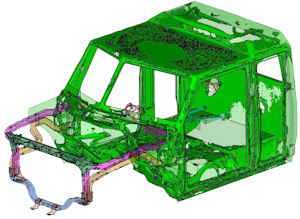Fast App: Lighter Weight Makes Heavier Duty
TPI Composites and Altair ProductDesign help create an innovative, minimum mass composite structure for border patrol vehicles.

Latest News
July 11, 2013
Off-road patrol vehicles are used to police the border between the U.S. and Mexico to restrict the number of immigrants attempting to enter the country illegally. The varied terrain between the two territories can be highly demanding on vehicles patrolling the area; they often need to drive at high speed over the rocky tracks.
 |
The vehicles are put through a punishing series of use conditions, far beyond what a normal off-road vehicle would be expected to withstand. As a result, the current vehicles used by the U.S. border patrol services typically last just six months before they need to be taken out of service.
Recent prototype border patrol vehicles have aimed at improving upon the six-month lifespan of existing vehicles, while still meeting the required performance characteristics. While the results have been positive, further performance and lifespan improvements could be made by reducing weight to enhance the chassis durability. Improvements in this area could result in a reduction in the overall cost of ownership.
The U.S. Military Tank Automotive Research Development and Engineering Center (TARDEC) supported a project to explore the potential weight advantages of using composite materials as an alternative to traditional steels for a patrol vehicle’s cabin and detainee box. The project was contracted to TARDEC’s established composites development partner, the University of Delaware Center for Composite Materials (CCM). Because of the extensive scope of the project, CCM worked closely with TPI Composites and Altair ProductDesign to assist with the program.
Concept Optimization
TPI Composites has a wide experience of the application of structural composites products for the wind energy, military and transportation markets. By combining its composite materials experience with Altair ProductDesign’s vehicle development expertise, a team was formed that could meet the challenges of creating lightweight, high-performance composite versions of the vehicle’s driver cab and detainee box.
 |
A constant requirement throughout the development process was to ensure that the end product be as lightweight as possible while still meeting performance targets. To achieve this goal, Altair ProductDesign performed a series of optimization studies that suggested where material was required in both structures and where it could be left out to save weight.
 |
To perform the initial “concept optimization” process, the team used Altair’s OptiStruct technology, the design optimization solution found within the Altair HyperWorks suite of simulation tools. In this process, performance targets and load cases that the vehicle would experience during a variety of use conditions were provided — along with the strength, stiffness and other characteristics of the composite material.
 |
Finally, the design space was defined, outlining where the optimization technology can and cannot add material to meet the design requirements. For example, a non-designable space would include the door openings on both the cabin and detainee box.
With the design considerations and constraints defined, OptiStruct generated a new material layout concept that was radically different to what an engineer would typically consider without the use of intelligent simulation. Altair ProductDesign’s vehicle development specialists used the topology optimization results as a guide to form a new layout for the composite material that would minimize the weight of the vehicle.
 |
Collaboration with TPI Composites was invaluable at this stage of the design, as the company’s composite material experts were able to inform the interpretation of the OptiStruct results to ensure that the suggested material layout met manufacturing guidelines.
Gauge Optimization
To further minimize the weight of the cabin and box, Altair ProductDesign performed a “gauge optimization” study. In this process, the composite material layout is further optimized to find its ideal thickness throughout the structure. Taking just a few millimeters of thickness away from the structure can result in significant weight savings, as well as minimizing the manufacturing cost and time associated with constructing composite components. A few examples of the gauge optimization process included:
- Thicknesses increased around the detainee box door cutout.
- Thicknesses increased along the seat bottom and edge.
- Directional reinforcement strips are not needed on the side walls.
 |
An Optimized Result
The final design of the cabin and detainee box met the performance criteria required for the off-road vehicle, while simultaneously minimizing the overall weight.
 |
By utilizing a concept optimization process, the team was able to create an innovative new design for the composite structure that only uses material where it is required.
Info
University of Delaware Center for Composite Materials
U.S. Army Tank Automotive Research, Development and Engineering Center
Subscribe to our FREE magazine, FREE email newsletters or both!
Latest News
About the Author
DE’s editors contribute news and new product announcements to Digital Engineering.
Press releases may be sent to them via [email protected].
Related Topics






